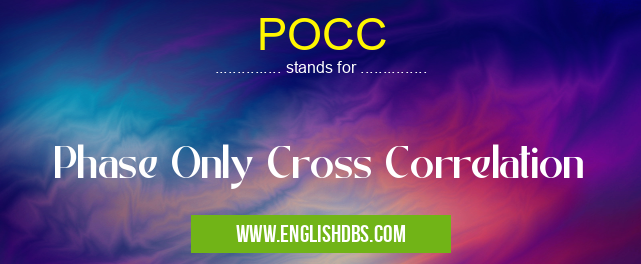What does POCC mean in UNCLASSIFIED
POCC is a technique used in image processing and pattern recognition to measure the similarity between two signals. It is a specialized form of cross-correlation that focuses solely on the phase information of the signals, ignoring their amplitude.

POCC meaning in Unclassified in Miscellaneous
POCC mostly used in an acronym Unclassified in Category Miscellaneous that means Phase Only Cross Correlation
Shorthand: POCC,
Full Form: Phase Only Cross Correlation
For more information of "Phase Only Cross Correlation", see the section below.
Introduction: Phase Only Cross Correlation (POCC)
How POCC Works
POCC works by calculating the cross-correlation between the Fourier transforms of the two signals. The Fourier transform of a signal decomposes it into its component frequencies and phases. By focusing on the phase information, POCC can identify similarities in the patterns of the signals, even if their amplitudes are different.
Applications of POCC
POCC has various applications in fields such as:
- Image registration: Aligning two images taken from different perspectives or under different conditions.
- Object tracking: Detecting and tracking moving objects in video sequences.
- Pattern recognition: Classifying objects based on their shape and structure.
- Biomedical imaging: Analyzing medical images to identify patterns and anomalies.
Advantages of POCC
- Robust to noise and illumination changes: POCC is less sensitive to noise and variations in lighting conditions than other cross-correlation methods.
- High accuracy: It can accurately detect small shifts and rotations in images.
- Computational efficiency: POCC can be implemented efficiently using the Fast Fourier Transform (FFT) algorithm.
Essential Questions and Answers on Phase Only Cross Correlation in "MISCELLANEOUS»UNFILED"
What is Phase Only Cross Correlation (POCC)?
Phase Only Cross Correlation (POCC) is a technique used in image registration to find the optimal alignment between two images. It involves correlating the phase information of the Fourier transforms of the images, rather than the amplitude information.
Why is POCC used for image registration?
POCC is particularly effective for image registration when the images have undergone significant non-rigid transformations, such as rotation, scaling, and shear. It is less sensitive to noise and illumination variations compared to other registration techniques.
How does POCC work?
POCC involves the following steps:
- Compute the Fourier transform of both images.
- Extract the phase information from the Fourier transforms.
- Correlate the phase information using the cross-correlation function.
- Find the peak in the cross-correlation function, which indicates the optimal alignment between the images.
What are the advantages of using POCC?
The advantages of using POCC include:
- Robustness to non-rigid transformations.
- Insensitivity to noise and illumination variations.
- Computational efficiency compared to other registration techniques.
What are the limitations of using POCC?
The limitations of using POCC include:
- May not be suitable for images with high levels of contrast variations.
- Can be sensitive to phase wrapping artifacts in the Fourier transforms.
In which applications is POCC commonly used?
POCC is commonly used in various applications, including:
- Medical image registration for tumor tracking, organ segmentation, and image-guided surgery.
- Remote sensing for image stitching and change detection.
- Industrial inspection for object detection and alignment.
Final Words: POCC is a powerful technique for measuring the similarity between signals by focusing on their phase information. It has proven useful in various applications, particularly in image processing and pattern recognition, due to its robustness, accuracy, and computational efficiency.
